Welcome to the heart of Portugal’s Alentejo region, where the enchanting city of Évora serves as a perfect base to explore the rich history and captivating landscapes of the surrounding area. From exploring the medieval streets and centuries-old architecture to wandering through megaliths older than Stonehenge, Évora is a wonderful place to visit for a day trip from Lisbon, a great stop en route to the Algarve, or as a base for a longer vacation in the Alentejo. This guide highlights what to see in the UNESCO World Heritage Site of Évora, offering a unique glimpse into Portugal’s past and present.
This post may contain affiliate links. If you make a purchase through these links, we will earn a small commission at no additional cost to you. We recommend products we have personally used or verified. Read the full disclosure here.
If you don’t have time to read this now, pin it for later!
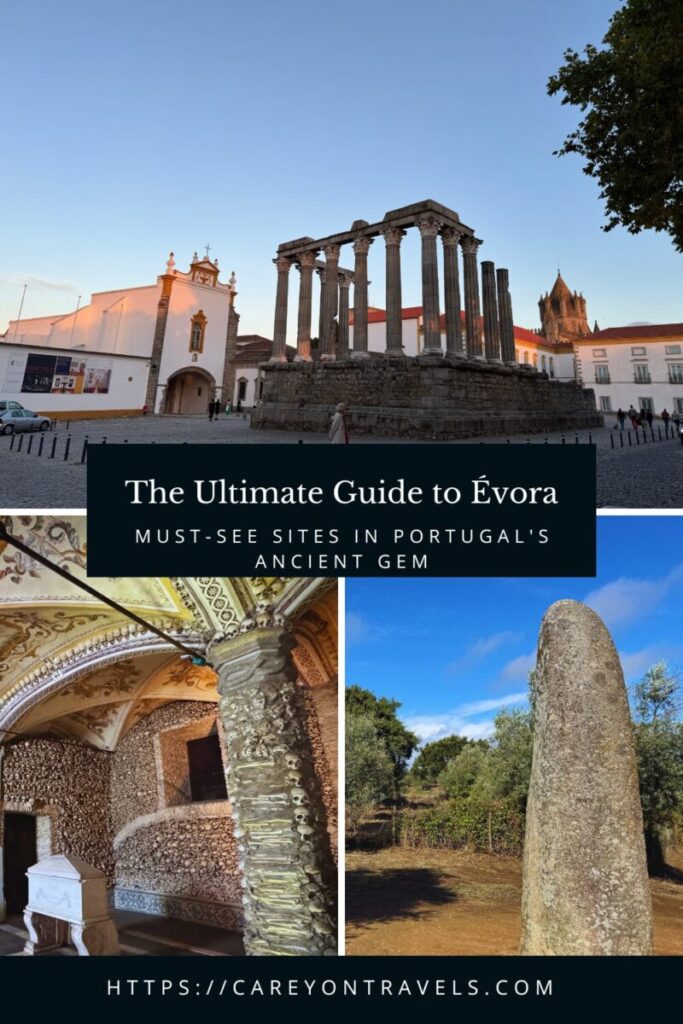
Is Évora Worth Visiting?
Is Évora worth visiting? Absolutely. This historic university city is the heart of Portugal’s Alentejo region, and offers a unique blend of culture, architecture, and historical significance that is rare to find. As a UNESCO World Heritage site, it boasts an array of well-preserved monuments that span centuries, from Roman ruins to medieval cathedrals and renaissance palaces, each telling a story of the ages. The city’s compact size makes it ideal for exploring on foot, allowing visitors to soak in its ancient charm and vibrant atmosphere at a leisurely pace. The Alentejo region is famous for its robust wines and rich cuisine, with an array of dining experiences to enjoy. For those looking to immerse themselves in the history, enjoy serene landscapes, and indulge in delicious food and wine, Évora is unquestionably worth a visit.
Évora History
The Évora area was first settled by ancient peoples, with megaliths estimated to date back to 6000 BC. It flourished under Roman rule as ‘Ebora Liberalitas Julia’ (the Liberty of Julius (Caesar)), marked by significant urban development including temples, baths, and walls. After the fall of the Roman Empire, Évora came under the influence of the Visigoths and later the Moors. Both left a lasting impression on the city’s architecture and culture.
In 1165, the Portuguese reclaimed Évora during the Christian Reconquista. Évora subsequently experienced a golden age in the 15th century when it became a residence of Portuguese kings. The University of Évora was established in the 16th century, turned Évora into a cultural center, attracting intellectuals and artists from around Europe. Visitors today can experience this rich history in every corner of the city, from medieval walls and Gothic cathedrals to Renaissance palaces and the mysterious cromlech nearby.
If you enjoy exploring Portugal’s history, don’t miss visiting the birthplace of Portugal, Guimarães.
What to See in Évora Portugal
- Roman Temple of Évora
- Évora Sé Cathedral
- Chapel of Bones (Capela dos Ossos)
- Giraldo Square (Praça do Giraldo)
- University of Évora
- Évora Museum
- Aqueduct of Silver Water (Água da Prata Aqueduct)
- Public Gardens (Jardim Público de Évora)
- Sunset at the Gardens of Diana (Jardim Diana)
- Garcia de Resende Theatre (Teatro Garcia De Resende)
- Cromeleque dos Almendres
- Menhir of Almendres (Menir dos Almendres)
1. Roman Temple of Évora
One of the top things to see in Évora at the Roman Temple, one of the most well-preserved Roman structures in Europe. Often referred to as the Temple of Diana, this architectural marvel dates back to the 1st century AD and provides a striking insight into the ancient Roman presence in Évora. Enjoy a coffee at the neighboring Jardim de Diana (gardens of Diana), where you can sit and enjoy the view of the temple. This temple is reminiscent of the Temple of Diana, just one of the incredible Roman ruins in nearby Mérida Spain.
If you enjoy visiting Roman artifacts, don’t miss one of our other favorites, the Roman bridge in Ponte de Lima, north of Porto.
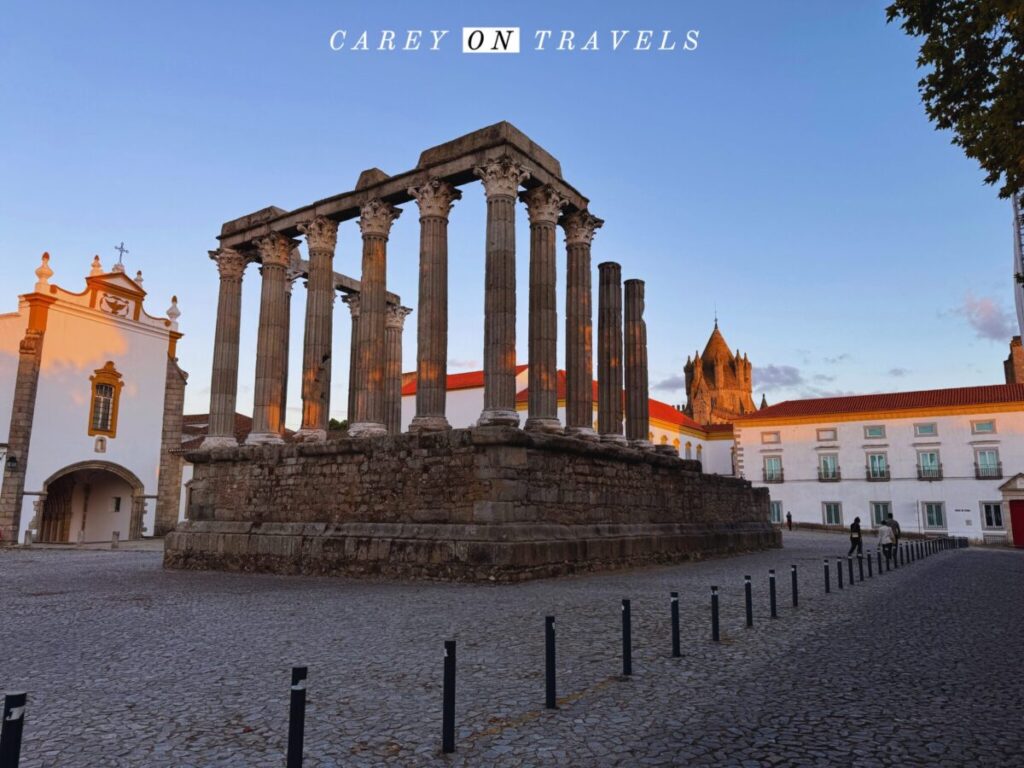
2. Évora Sé Cathedral
Afterwards, stroll to the Évora Sé Cathedral, a stunning example of Gothic architecture with the possibility to climb up to the roof for panoramic views. The narrow spiral stairway to the roof would be challenging for those visitors with mobility issues. After visiting the roof, continue on to the cloisters, where you’ll find another stairway to the lower rooftop walk (where the photo below was taken). This walkway area was completely empty when we visited.
There is a small entry fee for visiting the roof and cloisters. For a small additional cost, you can continue on to the museum, with extensive information on the cathedral’s religious history. No photos are allowed in the museum. There is a small café with courtyard as you exit. While we can’t vouch for the food, the interior courtyard is a wonderful spot for a coffee break.
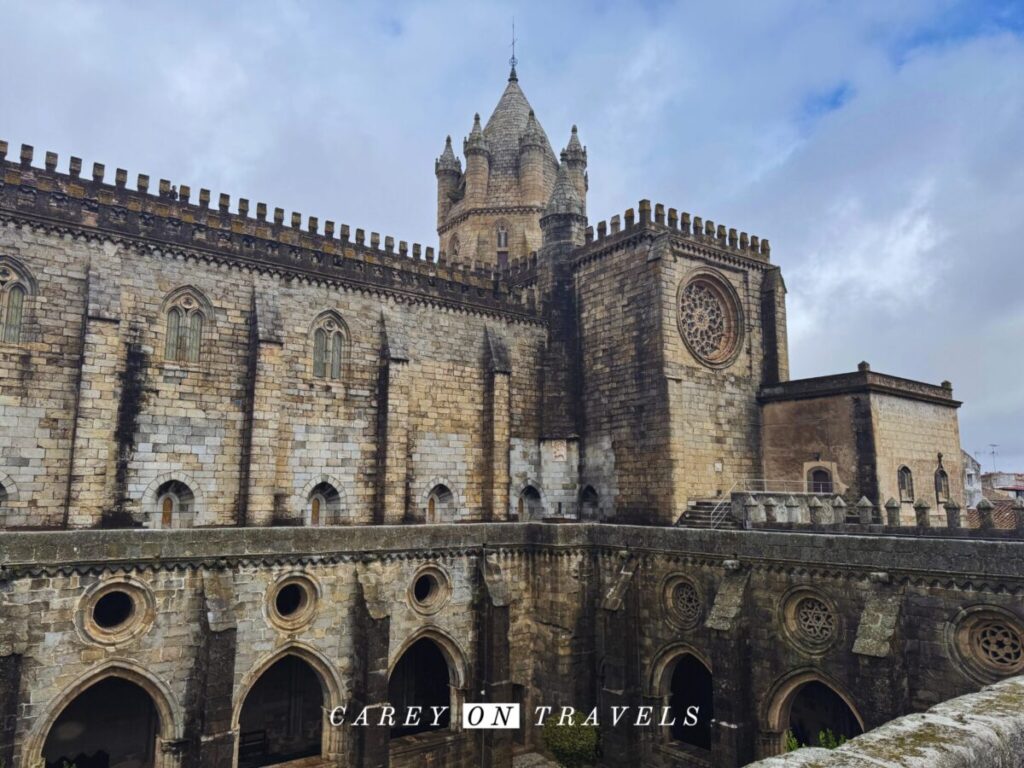
3. Chapel of Bones (Capela dos Ossos)
Don’t miss the Chapel of Bones at St. Francis Church, whose walls are lined with human skulls and bones. This eerie yet fascinating site features walls lined with human skulls and bones, intended to prompt reflection on the transient nature of life. After exiting the chapel, enjoy the display of nativity scenes from Évora in years past.
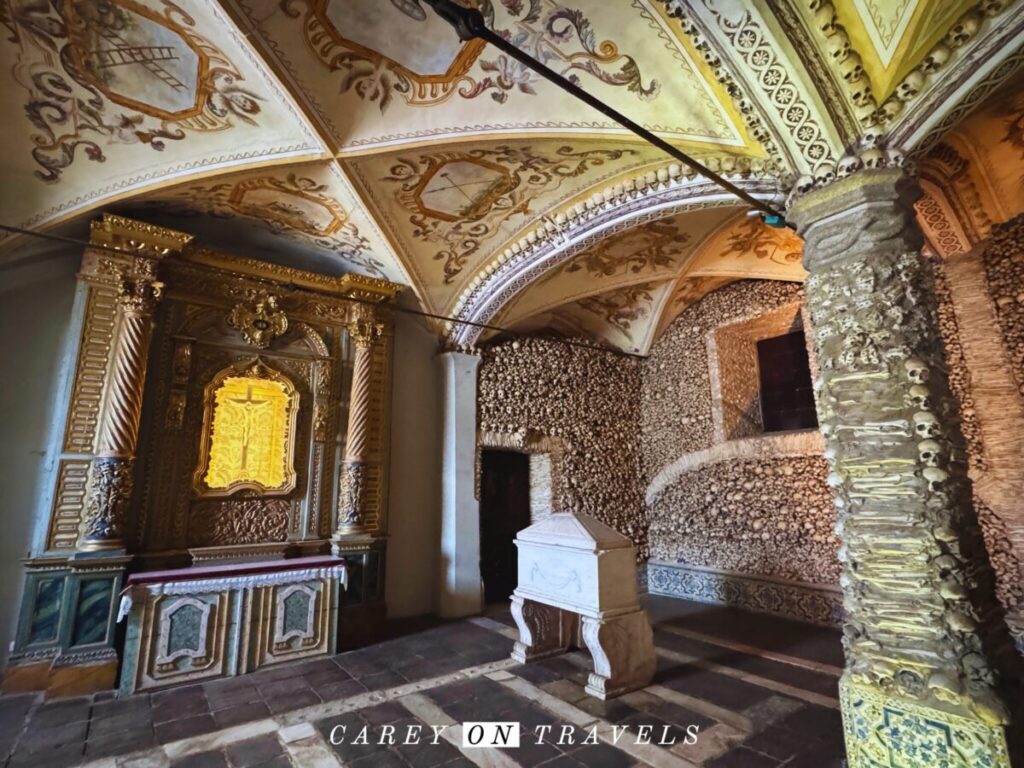
4. Giraldo Square (Praça do Giraldo)
Afterwards, lighten the mood with a visit to the lively Giraldo Square, where you can relax at a café and enjoy local cuisine. Don’t miss trying azevias de grão, a cinnamon and sugar-dusted sweet, which you can get at Pastelaria Conventual Pão de Rala.
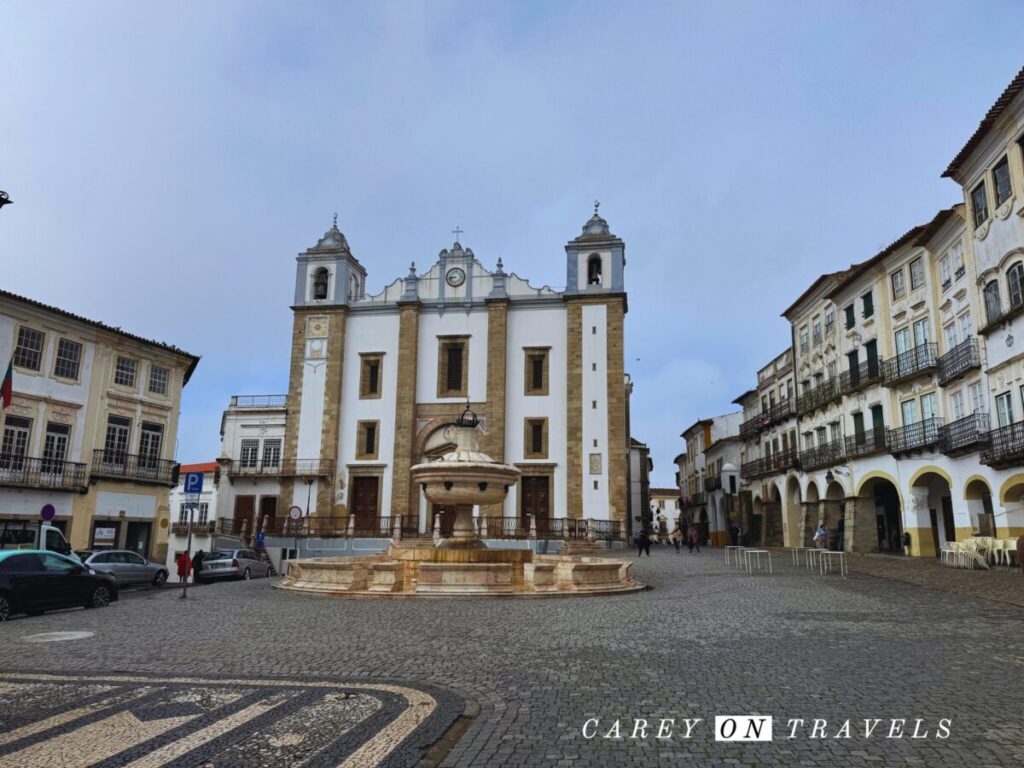
5. University of Évora
For a change of pace, head over to the University of Évora, one of the oldest universities in Portugal, founded in the 16th century. The university’s historic buildings and serene courtyards are a testament to Évora’s long-standing tradition of academic excellence. While you can wander around the buildings, there are some courtyards that require a ticket (or tour) to access them. This is one of the reasons we recommend taking a walking tour of Évora.
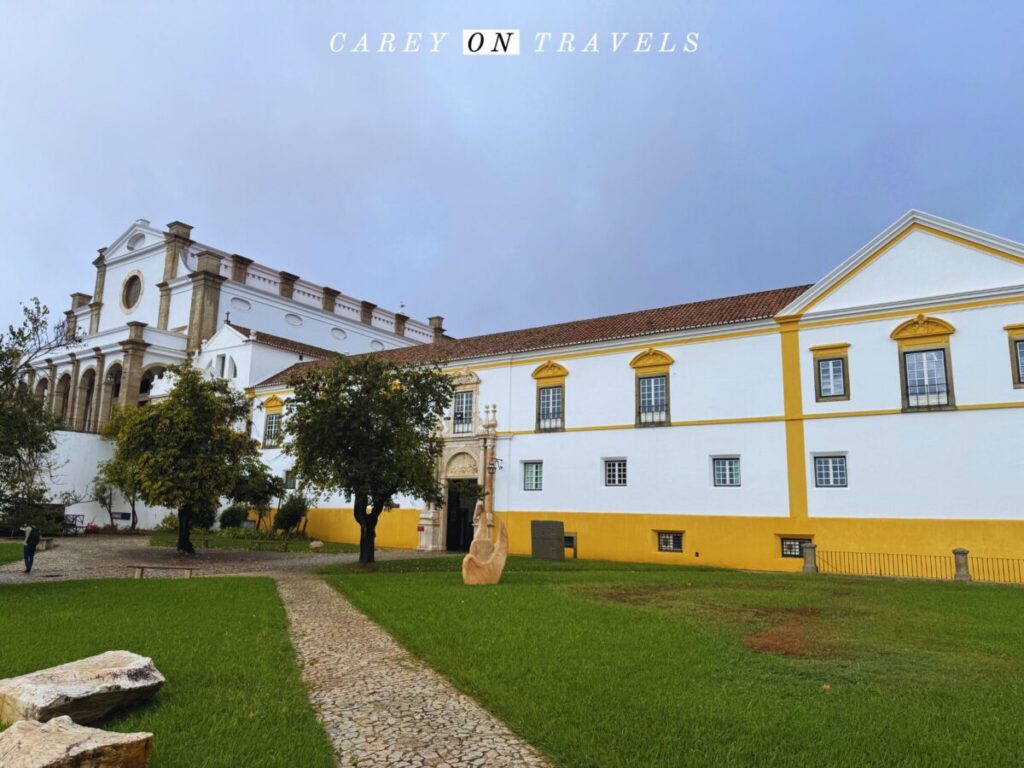
You will likely see college students wearing their long, black capes, that were the inspiration for the Harry Potter story. These are very reminiscent of the capes worn by the students in Coimbra.
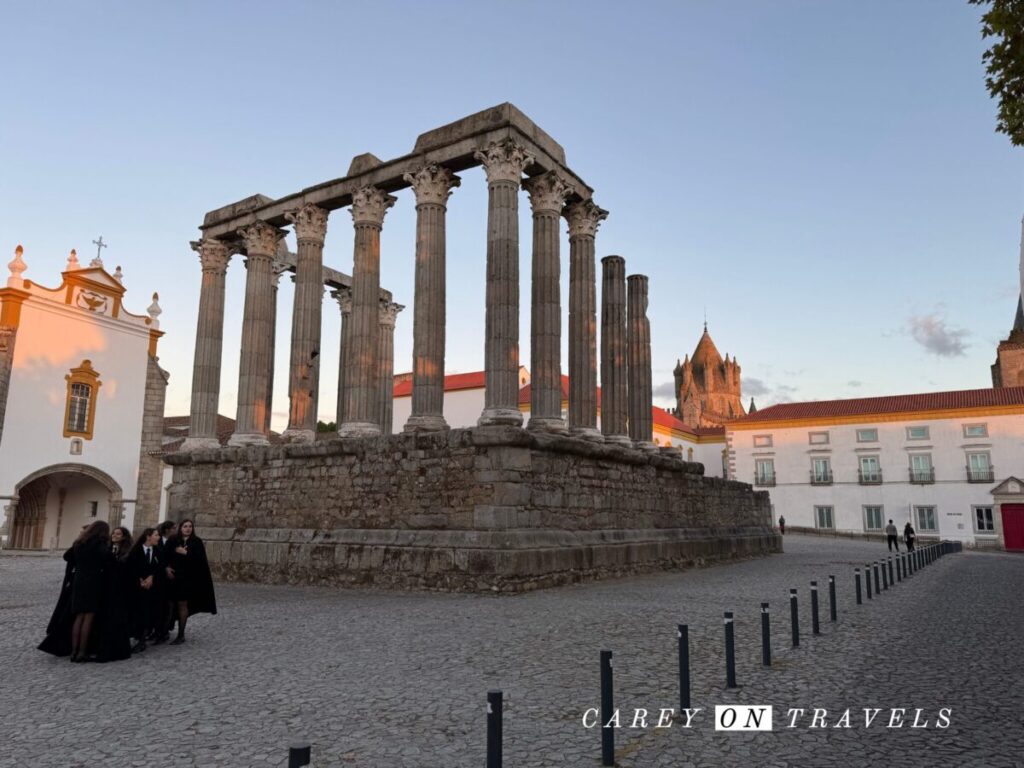
Consider one of these top rated walking tours below.
6. Évora Museum
For a deeper understanding of Évora’s history and culture, visit the Évora Museum, housed in the former Episcopal Palace. The museum boasts a rich collection of artifacts ranging from Roman mosaics to works by the famous Portuguese painter Francisco de Holanda. It is located just behind the Roman Temple and a few steps from the Sé Cathedral.
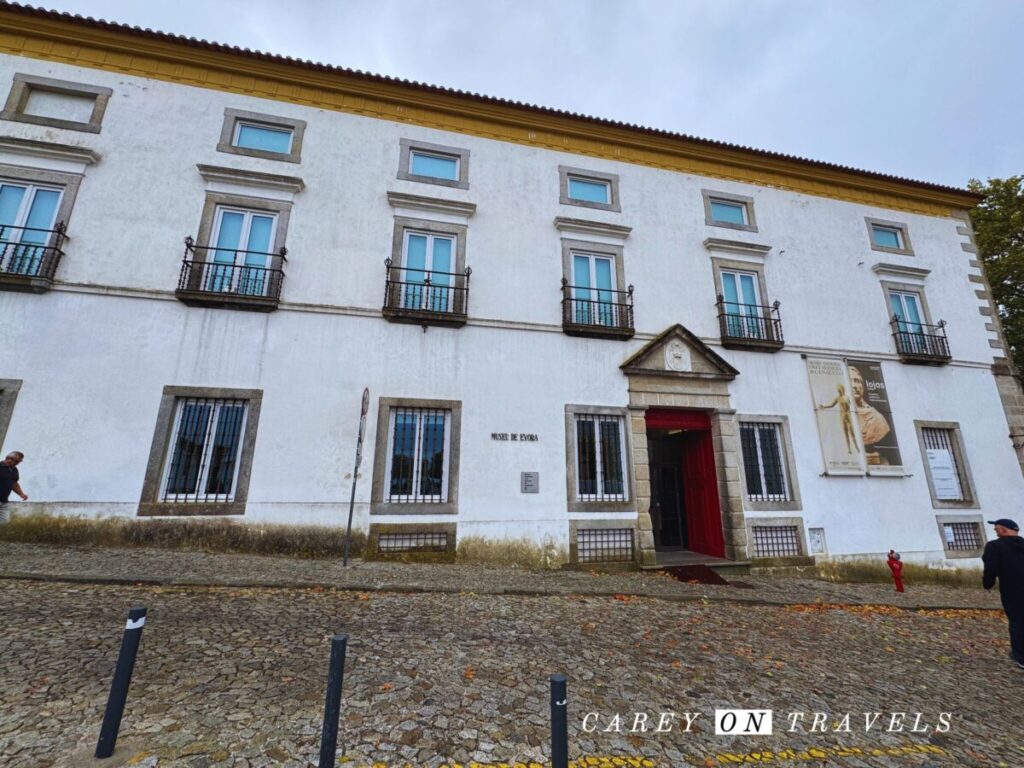
7. Aqueduct of Silver Water (Água da Prata Aqueduct)
Finally, explore the Aqueduct of Silver Water, an impressive 16th-century aqueduct that stretches through parts of the city. Take the time to wander through the historic old town to appreciate how this is integrated into modern life, with residences and shops built into the arches. This is one of our favorite parts of town, with fewer tourists than around the temple and cathedral.
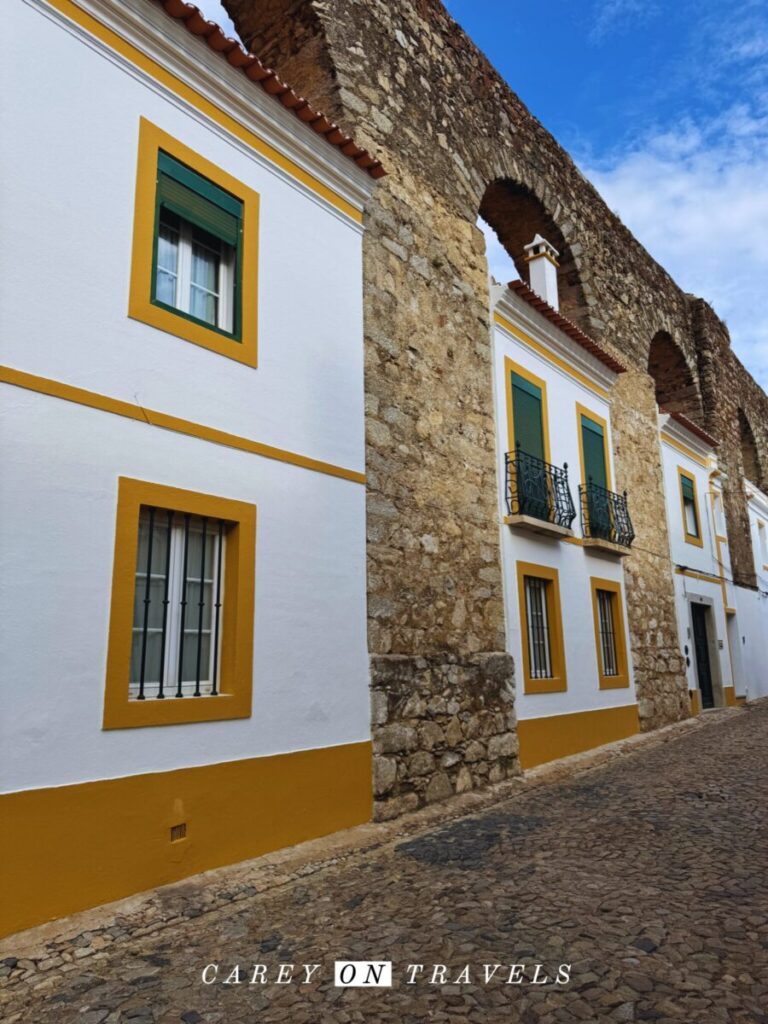
While walking around the historic center, be on the lookout for street art. It popped up in the most unexpected places around town.
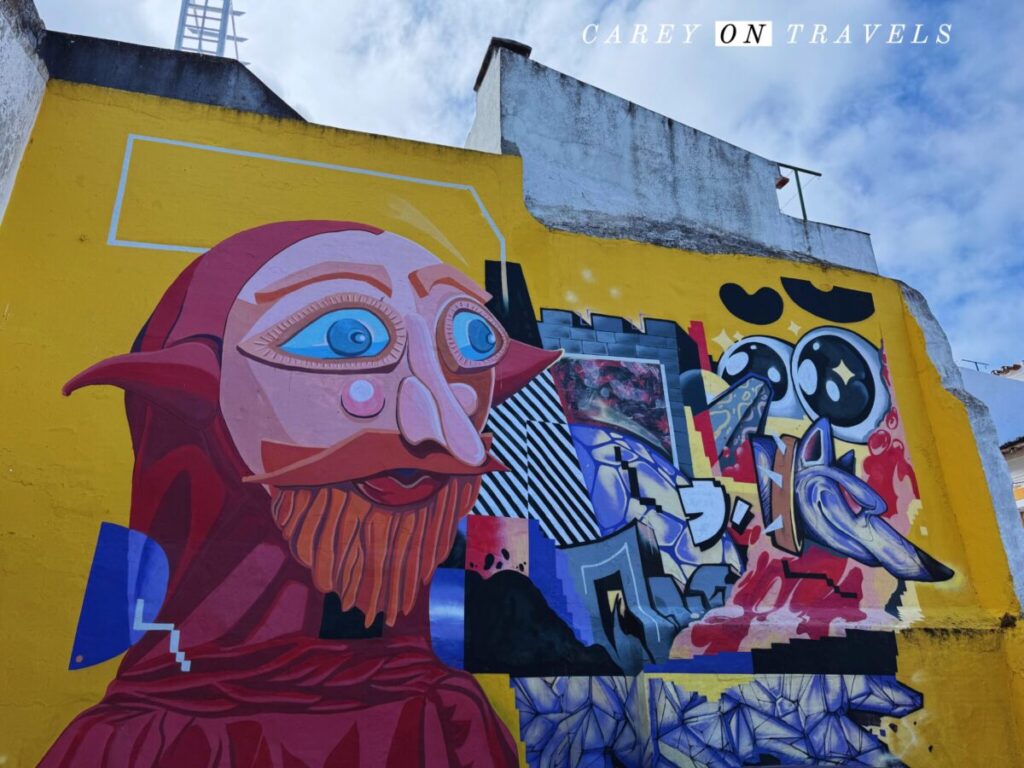
8. Public Gardens (Jardim Público de Évora)
Spend some time in the Jardim Público de Évora, a lush oasis in the heart of the city. These well-maintained gardens offer a peaceful escape with beautiful sculptures, fountains, a small lake, playground, and plenty of wandering peacocks. It is perfect for a leisurely stroll or a break from the city. The fake ruins are quite unique. The architectural materials for these ruins came from the ruins of several other city monuments.
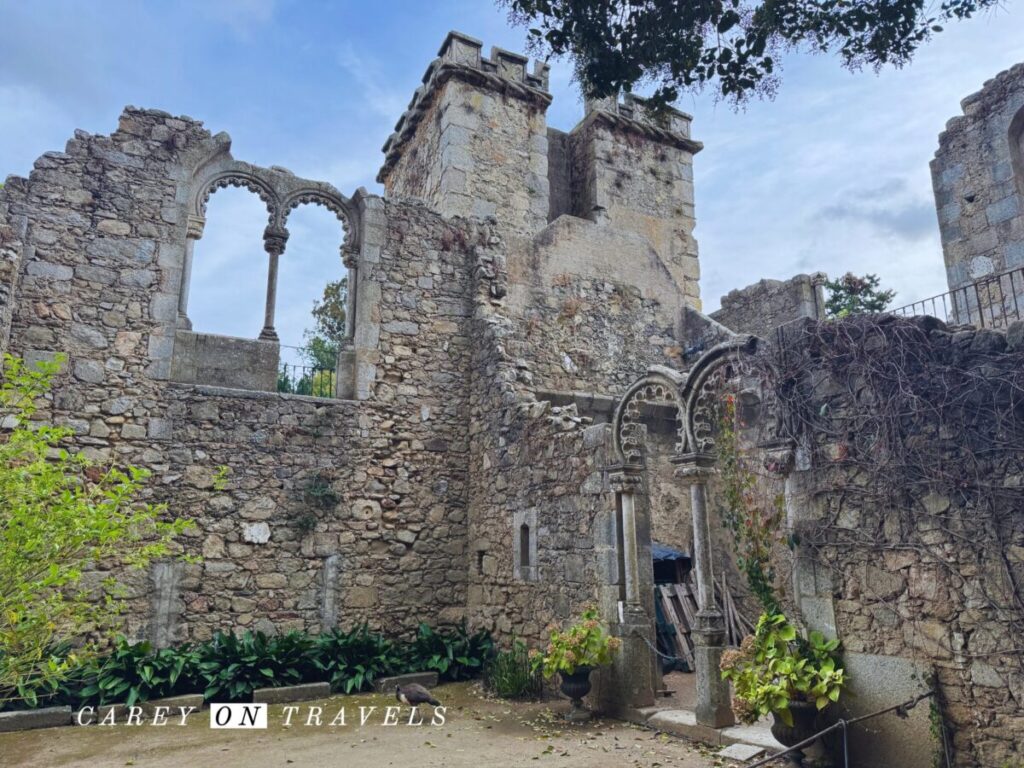
9. Sunset at the Gardens of Diana (Jardim Diana)
Circle the short distance back to the gardens of Diana (Jardim Diana) next to the Roman Temple for sunset. This is a popular spot amongst both locals, students, and tourists, though we’ve always found a spot to enjoy the view.
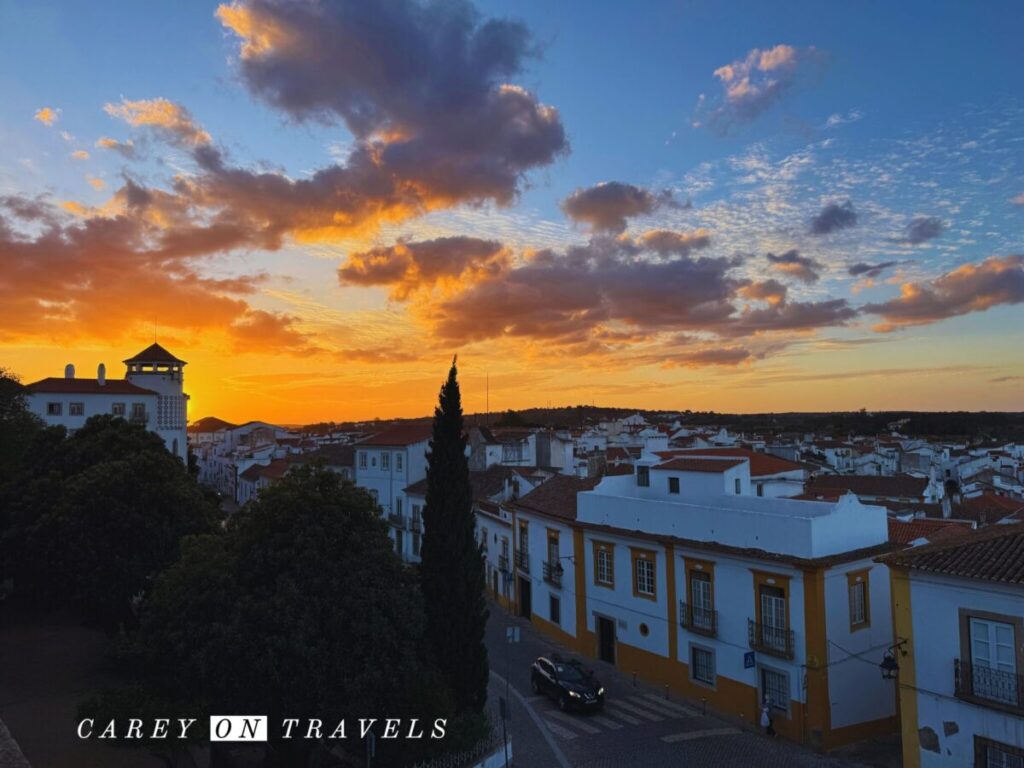
10. Garcia de Resende Theatre (Teatro Garcia De Resende)
Another gem in Évora is the Garcia de Resende Theatre, which has been a center of cultural life since the 19th century. Named after the Portuguese poet and architect, this historic theatre boasts a beautifully preserved interior that epitomizes the charm and grandeur of classical architecture. Visit and enjoy the architecture, or better yet, attending one of the performances. The theater hosts plays, concerts, and dance shows, featuring both local and international artists.
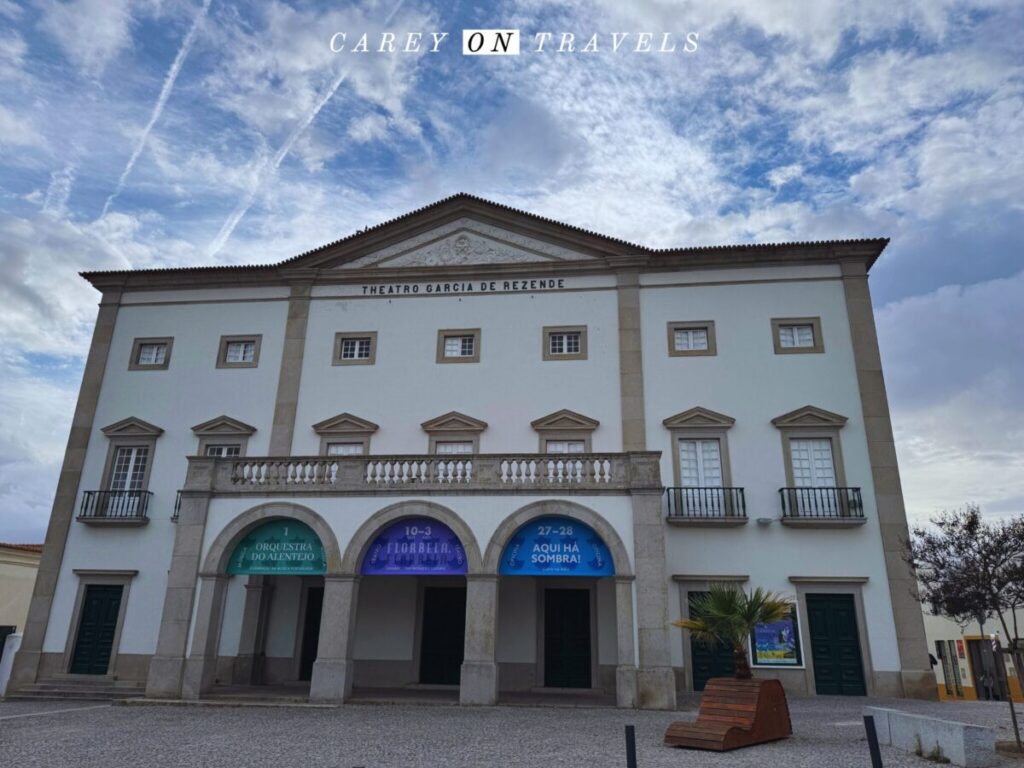
11. Cromeleque dos Almendres
Venture a short distance outside of Évora to visit the Cromeleque dos Almendres, one of Europe’s most significant megalithic complexes. This complex, which is older than Stonehenge (dating from 6000 BC), consists of an open-air circle of stones on a rolling hill. Unlike Stonehenge, you can walk right around these stones. If you are driving, stop at the Centro Interpretativo dos Almendres first to read up on the background of the megaliths before visiting the actual megaliths.
Tip: The road there is quite bumpy, made slippery if you visit just after it rains. If you have any concerns about driving, sign up for a tour for this outing.
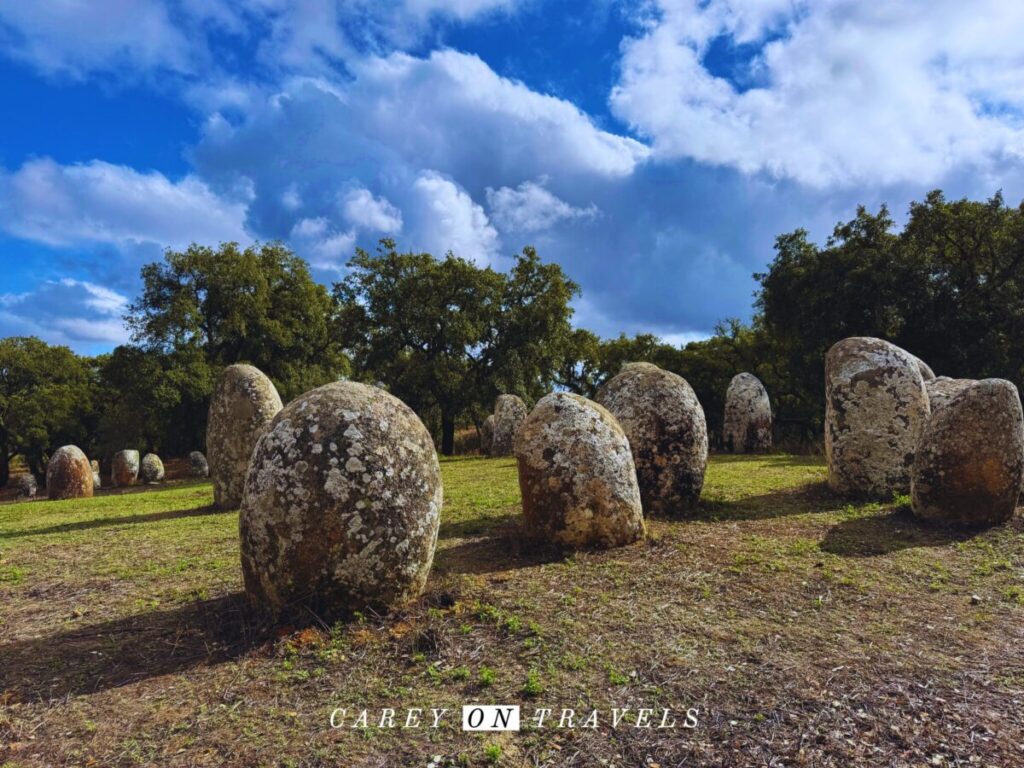
12. Menhir of Almendres (Menir dos Almendres)
On the return trip from the Cromeleque, make a stop at the Menhir of Almendres (Menir dos Almendres), standing on its own amidst olive trees. From the parking lot, there is a 10 minute walk on an uneven trail to get to the Menhir.
If you have more time, add a visit to the Anta Grande do Zambujeiro, a large dolmen that once served as a burial chamber, marveling at the early engineering skills of its builders.
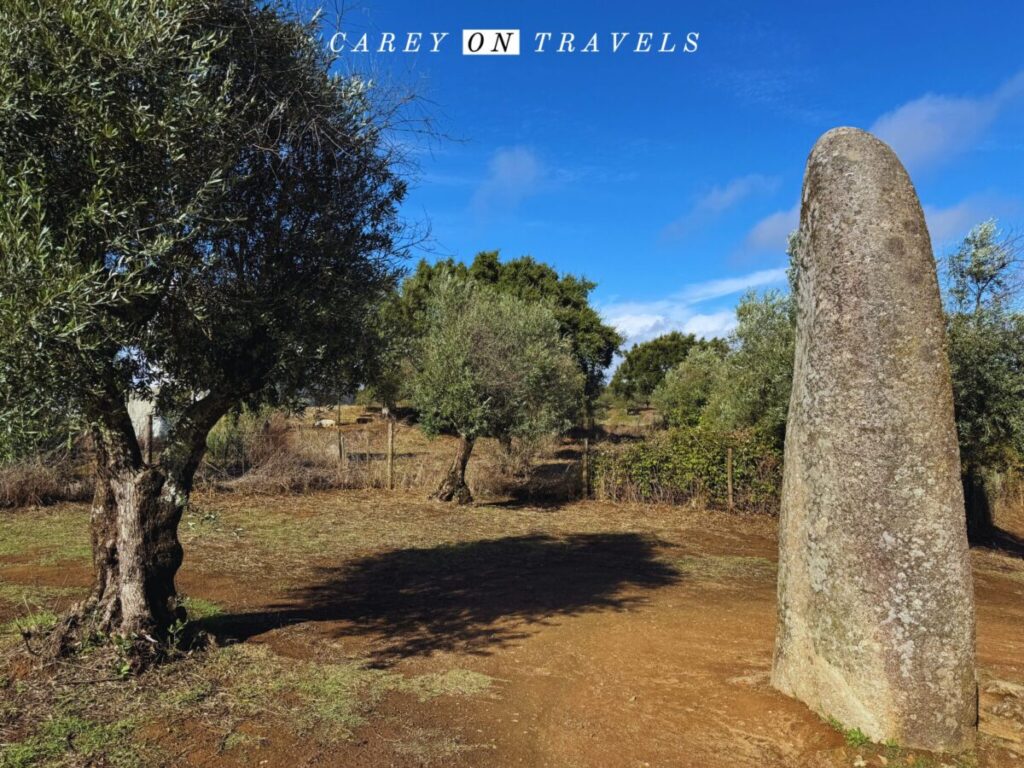
Day Trips from Évora
There are an incredible number of wonderful day trips from Évora to enjoy. Don’t miss these great day trips:
- Marvão, a beautiful hilltop town with 13th-century walls and a castle,
- Monsaraz, a white-washed medieval village that maintains a timeless charm,
- Alqueva reservoir, a huge man-made lake with plenty of opportunities for water activities,
- Estremoz, known as the Cidade Branca, or white city, for its white marble and Bonecos de Estremoz.
- Elvas, another UNESCO World Heritage site, with its incredible aqueduct, castle, and fortress,
- Museu do Chocalho (cowbell museum) in Alcáçovas.
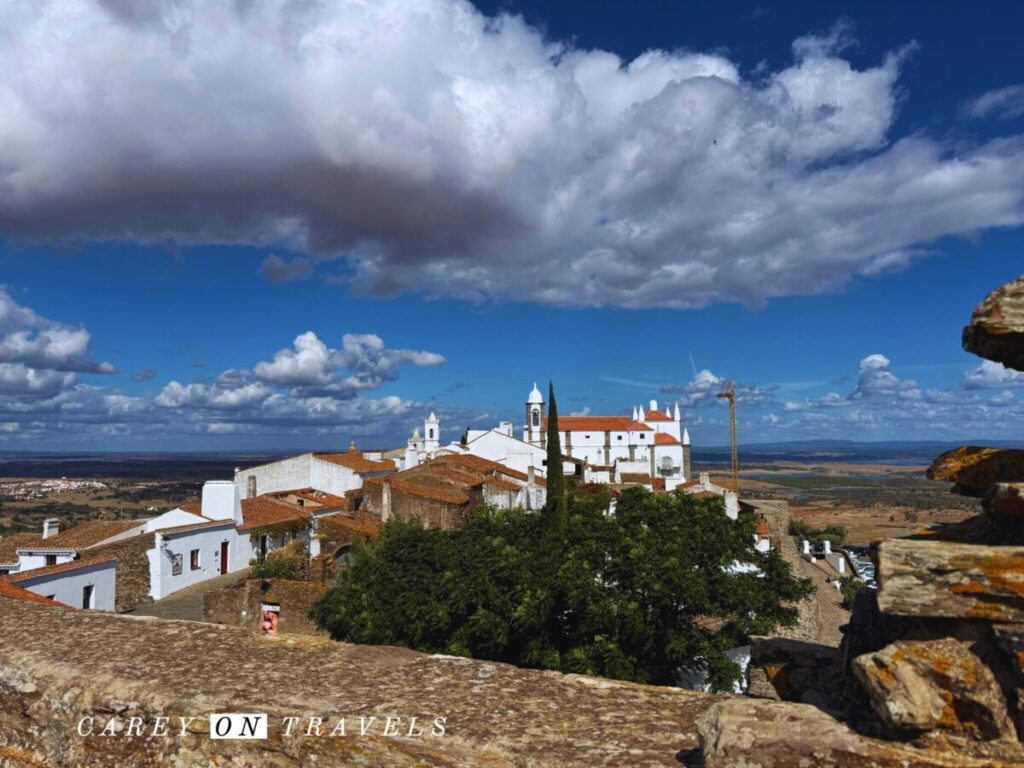
What to See in Évora Wrap-Up
Each day in Évora unveils something new, from the ancient stones to the quiet beauty of the surrounding hilltop villages. Based in Évora, this itinerary offers a perfect blend of exploration and relaxation, inviting travelers to immerse themselves in the depth of Portuguese culture and history.

Évora Travel Tips
Where is Évora?
Évora is approximately 130 kilometers east of Lisbon, in the Alentejo region. It is centrally located, making it an ideal base to explore to the broader Alentejo region. Évora is bordered by the Ribatejo to the north, the region of Beja to the south, and is close to both the Spanish border and the Atlantic coast, positioning it as a strategic cultural and historical hub. Its central location in the less densely populated Alentejo allows visitors to experience a blend of historical richness and the serene landscapes that define rural Portugal, making Évora a standout destination for those looking to explore beyond the hustle and bustle of Portugal’s coastal cities.
What is the Best Time to Visit Évora?
The best time to visit Évora is during the spring (April to June) and fall (September to early November). These seasons offer the most pleasant weather conditions—warm days and cool nights—ideal for exploring the vast landscapes and historical sites comfortably. In spring, the wildflowers in bloom enhance the scenic beauty of the rolling plains and ancient megaliths. Fall, particularly September through early November, is another excellent time to visit. The intense heat of the summer begins to wane, making outdoor activities more enjoyable. This period also coincides with the grape harvest (vindima), a festive time for the region’s wineries. Both spring and fall come with fewer tourists than in the bust summer months.
Don’t overlook winter though as a time to visit the Alentejo. Though it is cooler, this can be a wonderful time to explore Évora and the region’s other historical sights with little to no crowds. For those interested in hiking the Rota Vicentina, this can be a very quiet time on the trail.
How to Get to Évora
Getting to Évora is straightforward, whether you’re coming from within Portugal or from abroad. The city is well-connected by road and rail, making it accessible from major Portuguese cities.
| Driving from Lisbon | If you’re traveling from Lisbon, Évora is just a 1.5-hour drive on the A2 and A6 motorways. |
| Public Transport from Lisbon | Regular trains and buses run from Lisbon’s Oriente Station to Évora, with the journey taking approximately 1.5 to 2 hours |
| Tour from Lisbon | For those with less time to explore, or who may be interested in a day trip to Évora vs. a longer stay, check out some of the top tours to Évora below. |
For those renting a car, be sure to read up on tips and tricks for renting a car in Portugal before booking your rental. We use and recommend Discovercars for our rental cars.
Where to Stay in Évora
Évora offers a range of accommodations that blend historical charm with modern comforts, making it easy to find the perfect place to relax after a day of exploring. Be sure to check out our full set of recommendations on Where to Stay in Évora.
| Luxury: M’AR De AR Aqueduto | Within Évora’s historic walls, this luxurious hotel is built around a 16th-century chapel and part of the city’s ancient aqueduct. The hotel features spacious rooms, a gourmet restaurant, and a spa, in the heart of Évora. |
| Luxury: Convento do Espinheiro | Located just outside Évora, this luxurious historical hotel in a 15th century convent offers a tranquil retreat with lush gardens, an exquisite pool, and a divine spa. Its restaurant serves sumptuous dishes inspired by Alentejo cuisine. |
| Moderate: Vila Galé Évora | Just outside the historic city center, this hotel offers modernity and convenience, perfect for families or business travelers, with a large indoor pool and spa. |
| Moderate: Évora Olive Hotel | This modern hotel with olive-themed decor provides a comfortable and contemporary stay in the city center. It offers well-appointed rooms, excellent amenities including an outdoor terrace, and a location close to the attractions. |
| Budget-Moderate: Zoetic Sustainable Rooms | This boutique guesthouse offers a sustainable stay without sacrificing comfort. Located within the city walls, it features beautifully designed rooms using natural and recycled materials, and operates with a strong commitment to sustainability. Guests have access to a common lounge, kitchen, and terrace. |
You May Also Enjoy:
- Top Tips for Renting a Car in Portugal
- Best Destinations in Portugal in Winter
- 10 Activities in Lisbon Off-the-Beaten Path
- Best Places to Stay on the Fisherman’s Trail
- How to Plan Your Solo Portugal Fisherman’s Trail Hike
- Best Unique Places to Stay in Évora
- Portugal UNESCO Heritage Sites, Exploring Elvas
If you enjoyed this post, pin it for later!

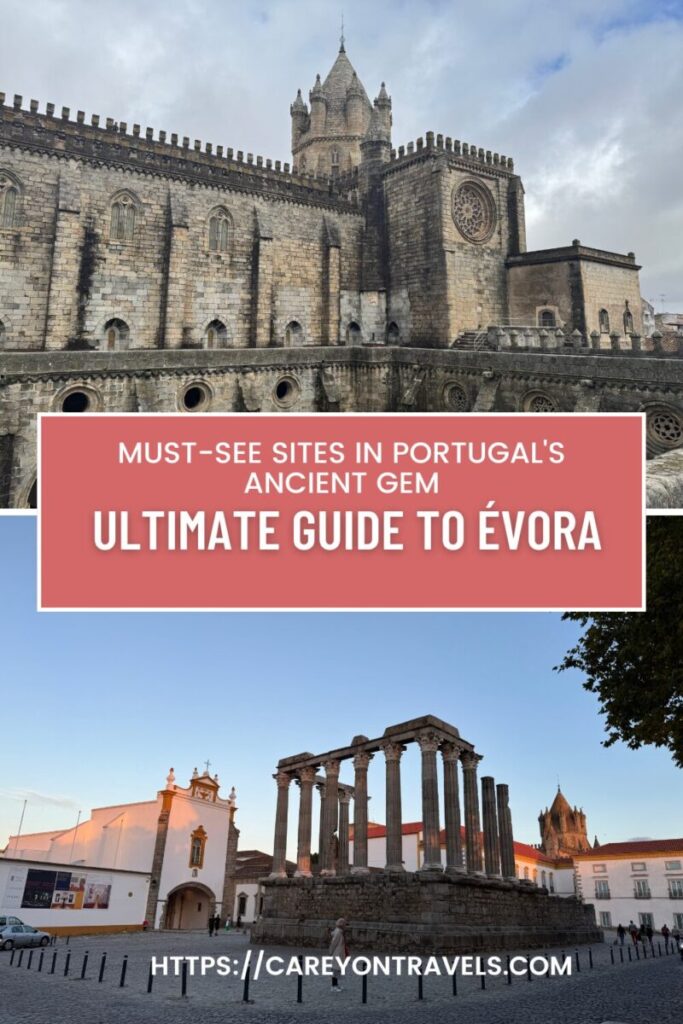
Travel Resources
We recommend booking through our preferred travel booking sites below.
| Air Travel | SkyScanner |
| Lodging | Booking.com, VRBO.com, Expedia.com, Hostelworld |
| Tours and Activities | Viator.com, GetYourGuide.com, TakeWalks.com |
| Car rentals | Discovercars.com |
| Travel insurance | Squaremouth |
| Bike and scooter rentals | BikeBookings.com |
| Train tickets | Trainline, RailEurope |
| Bus tickets | Flixbus, Busbud |

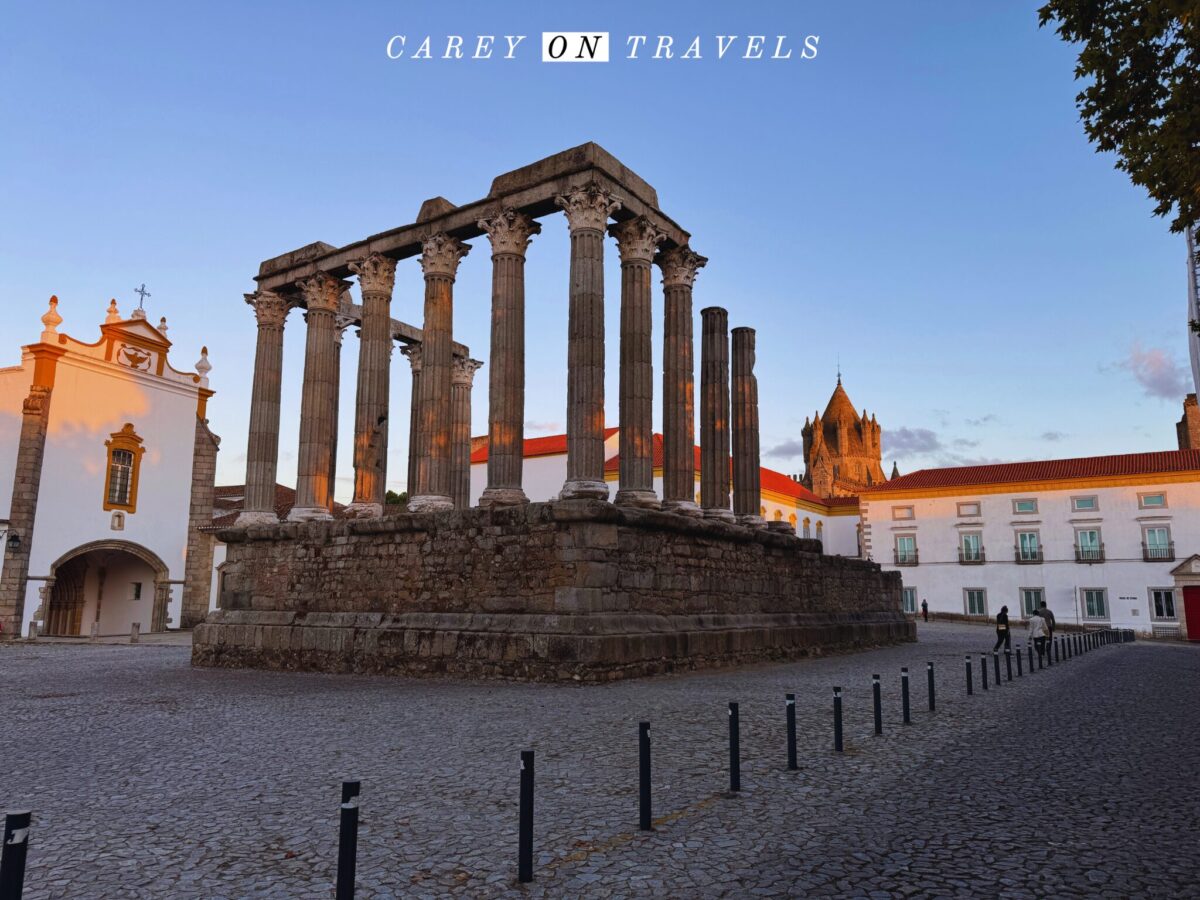



[…] UNESCO-listed city of Évora is an architectural gem in Portugal’s Alentejo region. Winter is a great time to take a walking […]
I never heard of Evora before so I totally missed it when I visited Portugal but it’s quite a charm and I love its history. Adding it to my next visit, thank you.
Évora has so much history and is such a unique university town, hope you can visit.
[…] just beyond Évora near Portugal’s eastern border with Spain, Elvas is a hidden gem filled with history, […]
[…] you enjoyed Lisbon, don’t miss traveling to Porto and northern Portugal, or heading south to Évora or to the […]
So sorry I missed Evora on my Podtuguese Summer! but there’s always next time! loved all your side trips!
All the more reason for a return trip!
Evora is one of the spots in Portugal I haven’t been able to visit yet but definitely want to get there soon.
Hope you have a chance to visit–such a great town with son much history.
Heard a lot about Evora from a friend who used to live there and I’d love to go on a day trip or something to explore this small town when I’m back in Portugal… This guide will definitely come in handy!
Hope you have a chance to visit, it’s a wonderful day trip (or longer).
Évora sounds like a beautiful place. I plan to travel to Portugal in the near future so I will try to visit this city when I go to Lisbon.
Great!
Evora is very much in our bucket list. It is similar and very close to Merida across the border on the Western Spain. I would love to explore this historical and architectural town. Your images look awesome!
I’ll have to add Merida to our list!
Never heard of this town but glad to learn about all the things to do here! Looks fun!
I love Portugal!! I didn’t have time to visit Evora on my first trip there though. But I would love to go back and check out the university and its students in their cloaks, and the cathedral looks gorgeous!
I’ve spent quite a bit of time in Portugal, yet I found Évora truly unique. Definitely worth a visit!
I actually haven’t heard of Evora but I love that it’s a day trip option from Lisbon. Hoping I have enough time on my trip to work it in!
It’s a fun day trip if you can squeeze it in!
Such a cool town! Thank you for all the information!
This city looks wonderful! I will check it out the next time I am in Lisbon. it’s appears to be the perfect day trip. thanks
It’s a great day trip (or longer), and a nice change of pace from Lisbon too.
Even though I am Portuguese, I have never been to Évora. I will try to visit this fall! Thank you for the amazing tips
Definitely worth a visit!
Evora is one of my favorite places in Portugal. Thanks for the nice memories.
Evora is beautiful. I missed places near Evora because I travelled by public transport on a day trip only.Maybe it’s a reason to return.
There are so many incredible places to visit just around Évora!
Those bone chapels always fascinate me. And that stark contrast from chambers of death to nativity scenes – that’s something!
It is quite the contrast, stepping out of the chapel and seeing reproductions of the nativity scenes just down the hall!
This article takes me back to Évora–I was fortunate to spend a couple of days there a few years ago, and your article reminds me of all the reasons I enjoyed my visit. I was skeptical about visiting the Chapel of Bones, but it was captivating and thought-provoking. Thanks for sharing!
Glad you enjoyed it. I was also skeptical about visiting the Chapel of Bones, but it was quite captivating as you mention.
Well we officially want to go to Portugal now! Love all the cathedral tours and the botanical garden is another top-of-our-list item!
Both were great to visit. The botanical garden is such a peaceful break after exploring sites.
[…] stepped back in time. If you enjoy exploring Portugal’s history, don’t miss visiting Évora, which was reclaimed and built by the Portuguese in […]
[…] If you enjoy visiting Roman artifacts, don’t miss the Roman Temple in Évora. […]
[…] mins agoAdd comment Share this article FacebookXRedditPinterestEmail Next article What to See in Évora, Portugal: A Traveler’s Guide Home » Blog » Places to Stay » Best Unique Places to Stay in Évora […]
[…] your rental to avoid hidden fees and challenges. If you do rent a car, consider stopping to explore the historic city of Évora on your way to or from the […]
[…] days ago51 comments Share this article FacebookXRedditPinterestEmail Previous article What to See in Évora, Portugal: A Traveler’s Guide Next article Top Things to Do in the Algarve in Winter Home » Blog » Portugal » Top […]